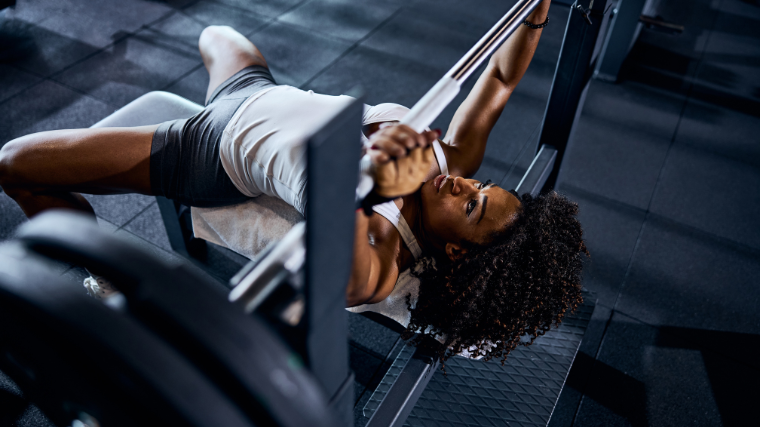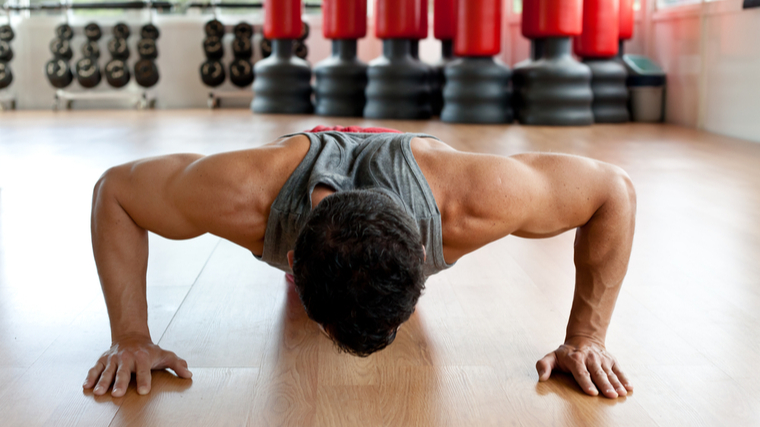The shortest distance between two points is a straight line. Reaching your goals in the gym, though, whatever they may be, isn’t always that simple.
If you want to get where you’re going, whether that’s increasing your strength, adding muscle, or improving your cardio, you need to know what potential pitfalls could be holding you back — and how to sidestep them.

Here are six possible reasons that your weight room progress might be meandering, slower than you’d like, or halted altogether. More importantly, you’ll also learn what to do about it.
Reasons You’re Not Progressing in the Gym
- Insufficient (or Low-Quality) Sleep
- Not Taking Your Rest Days Seriously
- Using Junk Volume
- Eating Too Many (or Too Few) Calories
- Mixing Cardio and Weight Training
- You’ve Reached Your Genetic Potential
Editor’s Note: The content on BarBend is meant to be informative in nature, but it should not be taken as medical advice. When starting a new training regimen and/or diet, it is always a good idea to consult with a trusted medical professional. We are not a medical resource. The opinions and articles on this site are not intended for use as diagnosis, prevention, and/or treatment of health problems. They are not substitutes for consulting a qualified medical professional.
Insufficient (or Low-Quality) Sleep
You don’t need to be a rabid gymgoer to recognize the importance of a balanced, consistent sleep schedule. Proper rest and recuperation is easy to take for granted, but you’ll definitely notice its absence if you put your sleep hygiene on the back burner.
Regarding the mechanisms that drive your progress in the gym — stress, recovery, and adaptation, with recovery being the real lynchpin here — there’s no way to out-train under-sleeping. You’ll probably feel like garbage both in and out of the gym.
Not only do sleep deprivation, insomnia, or inconsistent resting habits increase your propensity for fat gain, (1) but you’re likely to notice some adverse effects in real-time during your workouts.
Poor or insufficient sleep is all but guaranteed to reduce your alertness and reaction time, in addition to dampening your neuromuscular excitability (a fancy way of saying power output). (2)(3)
What’s more, cutting corners in the bedroom can also impact how you perceive physical effort and make easy work feel a whole lot harder than it actually is. (4)
How to Fix It
Fixing a sloppy sleep schedule can be easier said than done, but that doesn’t make it complicated. You can ensure that your rest habits are positively influencing your workout routine by making your bedtime as consistent as leg day.
Strive to go to bed at around the same time each night, and rise the next morning at a regular hour as well. You don’t need eight strict hours of sleep — everyone’s circadian rhythm is different, after all — but the amount of shut-eye you get each night shouldn’t vary too much either.
Simple actions like ensuring your bedroom is dark, limiting blue light exposure at night, or not performing strenuous exercise close to bedtime might help as well.
Not Taking Your Rest Days Seriously
Your choices outside the gym can impact your results far more strongly than you might think. You can liken this idea to gardening, in a sense. Your workouts are the seeds you plant, but nothing will grow unless you tend to the soil afterward.
If you take too few rest days, never program deloads or scheduled training breaks, or otherwise neglect your recovery outside the weight room, you’re not likely to make the aesthetic or performance changes you’re after.
For starters, muscle protein synthesis (the biological process that fuels the regrowth and regeneration of your muscle tissue) actually peaks up to 24 full hours following a training session, (5) indicating that there’s a delay in the efficacy of your training session.
Consuming adequate protein and calories on the days between workouts is equally, if not more, important as eating heartily on the days you hit the gym.
Further, there isn’t necessarily any harm to skipping the gym altogether when you need to. Research indicates that training continuously for weeks at a time yields the same overall gains compared to intermittently with breaks, at least in newer lifters. (6) Past a certain threshold, extra training might not be productive for you.
Narrative reviews that examine a variety of papers on bodybuilding habits also acknowledge that a balanced, consistent work-to-rest ratio is integral for making physique progress long-term. (7)
How to Fix It
There isn’t a hack or strategy here for you to employ. If you have designated rest days on your workout program, whether you work with a coach or follow a template, respect your time off from the gym.
The same holds true for when you’re feeling particularly beaten up, demotivated, or downtrodden. There are peaks and valleys to every athlete’s career, and barring extreme circumstances like a big competition, there’s little to be gained by fighting the current.
Also, remember that you can do things outside the gym that will improve your performance inside. Adequate nutrition (particularly protein and calories), high-quality sleep, and limiting stress when possible will do a tremendous amount for your overall fitness.
Using Junk Volume
All the work you do in the gym isn’t created equal. If you let your effort, focus, or intensity slide — particularly with regard to resistance training — your workouts might be chock-full of junk volume without you even realizing it.
“Junk” volume refers to low-quality work; sets that aren’t necessarily productive from a strength or hypertrophy standpoint, but are just hard enough to make you tired.
There’s a broad correlation between set volume and hypertrophy or strength gains. Doing more work will help you grow, but only up to a point. Pushing yourself beyond that threshold will likely yield diminishing returns, or even cause you to regress. (8)(9)
It’s perfectly possible to keep lifting during a session even after you’ve exhausted your “hypertrophic potential” for the day. Or, you might be underestimating yourself and adding more exercises or sets in an attempt to spur growth when fewer movements with more effort would do the trick.
Both qualify as junk volume, which can quickly run rampant throughout your routine.
How to Fix It
If your workouts feel bloated, or you end each training week exhausted but aren’t seeing the gains you’re after in the mirror, on the barbell, or on the scale, your training might be rife with junk volume.
Clean house and reduce your overall training volume back to a reasonable baseline. Most literature suggests that the upper ceiling for “productive” resistance training is somewhere between 10 and 20 hard sets per muscle group per week. (8)
Note that there is variance here depending on your experience level, nutritional habits, and the like. But if you’re easily exceeding that range, you might not be putting in enough effort on a set-to-set basis.
Alternatively, you can perform AMRAP sets every couple of weeks during your workouts to truly find out what you’re capable of. If you typically perform sets of eight on the bench press, load up the same weight as you usually do, grab a spotter, and go until you fail.
If you comfortably hit more than 12 or 13 reps, it’s probably time to add weight. Remember that effective training is more about working in proximity to failure at least most of the time, regardless of the rep range itself. (9)(10)
Eating Too Many (or Too Few) Calories
The laws of thermodynamics are mostly absolute — if you want to gain body weight, you need to eat more than you burn. The inverse holds true for losing weight just as well.
However, this isn’t an excuse to write yourself a blank check when you’re bulking, or run yourself ragged while you’re on a cut.
An excess of calories are usually required to facilitate hypertrophy (unless you’re brand new to the gym, are significantly overweight, or haven’t trained at all in years). That said, there’s a ceiling to the efficacy of eating more.
Uncapped caloric surpluses have not been shown to encourage any more muscle growth than moderate, controlled bulking phases provide. (11) “Dirty bulking” will move the needle on the scale faster, but that added weight is likely to come from body fat instead of lean mass.
Conversely, a steep caloric deficit will hasten your rate of weight loss but, eventually, you’re just as likely to start burning through your hard-earned muscle as you are fat. Your body can only pull stored fat for energy so quickly.
This threshold varies from person to person, but daily deficits of roughly 700 calories or more may start chewing into the wrong energy reserves. (12)
On the performance side of the coin, excessive and prolonged caloric deficits can prohibit you from gaining strength for months at a time, even after you return to maintenance calories or above. (13)
Note: The study cited above was conducted on bodybuilders who committed to extremely strict contest prep diets, which may have created more stressful outcomes than the average dieter should worry about.
How to Fix It
For most people, the best way to sidestep the perils of over (or under) eating involve practicing moderation.
If you’re concerned about the potential consequences of a “dirty” bulking phase, make sure you cap your calorie intake at a reasonable level (an extra 500 calories ingested per day would yield one pound of weight per week, generally speaking).
Calorie Calculator
Conversely, it’s equally important to avoid excessive restriction when you’re dieting. Eating a very low amount of calories isn’t sustainable for most folks most of the time — patience and consistency will be your strongest allies here.
Mixing Cardio and Weight Training
There’s absolutely no harm in pursuing different goals in the gym. After all, everyone’s definition of fitness is different, and you should strive to define it yourself.
That said, stretching yourself too thin athletically might be interfering with your ability to make progress. This phenomenon is categorized in the literature as the interference effect.
Put simply, your body only has so many resources available, and the metabolic processes behind endurance-based and strength-based tasks are funneled through many of the same biological “channels.”
Researchers have documented that high-level weight lifting and cardiovascular exercise performed concurrently may yield poorer results than if you had worked on them at separate times. (14)(15)
You may also notice that performing a cardio workout before a resistance training session limits your strength, muscular endurance, or focus with weights. (16)
How to Fix It
There’s no reason that you can’t improve your cardio game and get bigger or stronger in the gym at the same time. If you have particularly strong goals in either of those areas, though, you may have to accept putting the other on the backburner for the time being.
For a short-term solution, you may find success in performing your weight training before you run, jog, hike, swim, or do a HIIT workout. As the biological impetus on the body is different for lifting and cardio, you shouldn’t notice much of a loss in performance when you lace up your running shoes (this may not be as true on leg day).
Alternatively, properly-programmed cardio can be a great form of active recovery on the days you aren’t in the weight room. Low or moderate-intensity endurance work may even help you bounce back from muscle soreness a bit quicker, too.
You’ve Reached Your Genetic Potential
One potential culprit behind your lagging progress in the mirror or on the lifting platform has nothing to do with your diet, recovery habits, or how hard you go in the weight room.
If you’ve been properly training (while also staying on top of your health habits outside the gym) for a number of years, there’s a chance that you’re simply approaching your natural limit for muscularity.
While some research has attempted to model the influence of genetics on muscle mass, results vary wildly and little exists in the way of concrete, actionable data. (17)
Among industry experts, there’s an equally contentious debate. Conservative projections range from as little as two to three pounds of lean body mass per year of training after four or five years in the gym, while researchers like Dr. Eric Helms remark that “advanced” trainees can expect something like .25 to .5 percent of their bodyweight gained per month — if both training and diet are impeccably maintained. (18)
With regard to “performance potential,” the waters get even murkier. While you almost certainly do have some vague ceiling for how strong you can get or far you can run, these metrics haven’t been extensively studied in a way that would be useful to the average gymgoer.
How to Fix It
Unlike a poorly-calibrated training routine or a slacking-at-best diet, there’s nothing to do if you’ve hit your limit for muscle growth or strength gain.
On the upside, obsessing over this idea is a zero-sum game that is likely to do you far more harm than good. There’s no good reason to worry about how far you can get athletically, especially if you don’t have a decade of airtight gym experience under your belt already.
Exercise is good for a lot more than helping you run fast or adding inches to your arms — it can be a source of joy, an opportunity for stress relief, and a whole lot more.
If you are convinced there’s no more juice left to be squeezed out of your physique, you can also recontextualize why you train in the first place. Look to different, untapped avenues for progress, such as:
- Improving your flexibility or mobility.
- Picking up a new style of training, such as calisthenics.
- Set a short-term goal for yourself, like competing in your first weightlifting meet.
Training, as well as the goals you set for yourself, don’t have to be rigid fixtures in your life. They can adapt, change, and grow along with you over time.
Your Takeaways
Your rate of progress in the gym won’t always be consistent. Sometimes you’ll soar, others you’ll stumble. Many common culprits for a lack of progress, though, are things you can remedy.
- Many of the issues holding you back from progress in the gym are related to dosage in some form.
- Too many (or few) calories, insufficient rest, or too much training volume can all affect how much faster, stronger, bigger, or leaner you become.
- Some issues are genetic, but dwelling on factors outside of your control isn’t a productive use of your time in the first place.
Keep an eye on the big things — training intensity, having the right exercises, a clear and defined goal to strive for — but don’t turn a blind eye to some of the more subtle problems that may plague your health.
Progress Over Perfection
Even the greats of the iron game fall off the wagon from time to time. No high-level athlete can paint their trajectory to the top with one smooth, unbroken line. No matter where you’re headed, you’re likely to run into some issues along the way.
What matters is how you handle them. Building a long, healthy career in the gym is all about identifying problems and attacking them as ferociously as you attempt a new personal record.
References
- Patel S. R. (2009). Reduced sleep as an obesity risk factor. Obesity reviews : an official journal of the International Association for the Study of Obesity, 10 Suppl 2, 61–68.
- Goel, N., Rao, H., Durmer, J. S., & Dinges, D. F. (2009). Neurocognitive consequences of sleep deprivation. Seminars in neurology, 29(4), 320–339.
- VanHelder, T., & Radomski, M. W. (1989). Sleep deprivation and the effect on exercise performance. Sports medicine (Auckland, N.Z.), 7(4), 235–247.
- Rodgers, C. D., Paterson, D. H., Cunningham, D. A., Noble, E. G., Pettigrew, F. P., Myles, W. S., & Taylor, A. W. (1995). Sleep deprivation: effects on work capacity, self-paced walking, contractile properties and perceived exertion. Sleep, 18(1), 30–38.
- MacDougall, J. D., Gibala, M. J., Tarnopolsky, M. A., MacDonald, J. R., Interisano, S. A., & Yarasheski, K. E. (1995). The time course for elevated muscle protein synthesis following heavy resistance exercise. Canadian journal of applied physiology = Revue canadienne de physiologie appliquee, 20(4), 480–486.
- Ogasawara, R., Yasuda, T., Sakamaki, M., Ozaki, H., & Abe, T. (2011). Effects of periodic and continued resistance training on muscle CSA and strength in previously untrained men. Clinical physiology and functional imaging, 31(5), 399–404.
- Alves, R. C., Prestes, J., Enes, A., de Moraes, W., Trindade, T. B., de Salles, B. F., Aragon, A. A., & Souza-Junior, T. P. (2020). Training Programs Designed for Muscle Hypertrophy in Bodybuilders: A Narrative Review. Sports (Basel, Switzerland), 8(11), 149.
- Krieger, James. (2010). Determining Appropriate Set Volume for Resistance Exercise. Strength & Conditioning Journal. 32. 30-32. 10.1519/SSC.0b013e3181df16f4.
- Morton, R. W., Oikawa, S. Y., Wavell, C. G., Mazara, N., McGlory, C., Quadrilatero, J., Baechler, B. L., Baker, S. K., & Phillips, S. M. (2016). Neither load nor systemic hormones determine resistance training-mediated hypertrophy or strength gains in resistance-trained young men. Journal of applied physiology (Bethesda, Md. : 1985), 121(1), 129–138.
- Schoenfeld, B. J., Contreras, B., Ogborn, D., Galpin, A., Krieger, J., & Sonmez, G. T. (2016). Effects of Varied Versus Constant Loading Zones on Muscular Adaptations in Trained Men. International journal of sports medicine, 37(6), 442–447.
- Garthe, I., Raastad, T., Refsnes, P. E., & Sundgot-Borgen, J. (2013). Effect of nutritional intervention on body composition and performance in elite athletes. European journal of sport science, 13(3), 295–303.
- Huovinen, H. T., Hulmi, J. J., Isolehto, J., Kyröläinen, H., Puurtinen, R., Karila, T., Mackala, K., & Mero, A. A. (2015). Body composition and power performance improved after weight reduction in male athletes without hampering hormonal balance. Journal of strength and conditioning research, 29(1), 29–36.
- Rossow, L. M., Fukuda, D. H., Fahs, C. A., Loenneke, J. P., & Stout, J. R. (2013). Natural bodybuilding competition preparation and recovery: a 12-month case study. International journal of sports physiology and performance, 8(5), 582–592.
- Hawley J. A. (2009). Molecular responses to strength and endurance training: are they incompatible?. Applied physiology, nutrition, and metabolism = Physiologie appliquee, nutrition et metabolisme, 34(3), 355–361.
- Fyfe, J. J., & Loenneke, J. P. (2018). Interpreting Adaptation to Concurrent Compared with Single-Mode Exercise Training: Some Methodological Considerations. Sports medicine (Auckland, N.Z.), 48(2), 289–297.
- Fyfe, J. J., Bishop, D. J., & Stepto, N. K. (2014). Interference between concurrent resistance and endurance exercise: molecular bases and the role of individual training variables. Sports medicine (Auckland, N.Z.), 44(6), 743–762.
- Charlier, R., Caspers, M., Knaeps, S., Mertens, E., Lambrechts, D., Lefevre, J., & Thomis, M. (2017). Limited potential of genetic predisposition scores to predict muscle mass and strength performance in Flemish Caucasians between 19 and 73 years of age. Physiological genomics, 49(3), 160–166.
- McDonald, L. (2009) “Four Models for Genetic Muscular Potential”, Body Recomposition.
Featured Image: LightField Studios / Shutterstock






